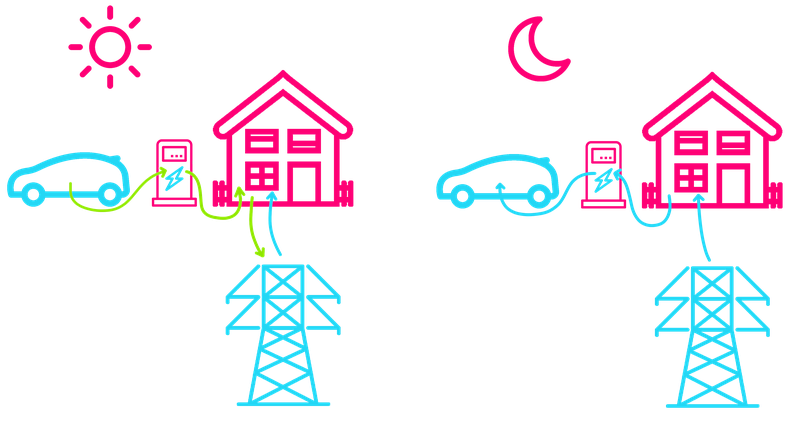
Guide To… Vehicle-to-Grid Charging
The perks of electric vehicles don’t just stop at zero emissions and lower running costs. The entire purpose of switching to an EV is to break free of the stranglehold of fossil fuels in order to live a cleaner, more sustainable life.
We have already detailed how electric cars can be run on renewable energy alone in order to truly drive emissions-free, and how electric car batteries can be reused to store renewable energy in your home or business.
Today we’re looking at an often overlooked perk of electric vehicles: Vehicle-to-Grid charging.
What Is Vehicle-to-Grid?
When we charge our electric cars at home – the primary place of charging electric vehicles due to lower cost and lower carbon intensity – the car is connected to our house via a cable, so that energy from our homes can be transferred to our cars.
Vehicle-to-Grid reverses this, allowing energy from your car to be used to power your home, or to be fed back into the national electricity grid.
While not every car or home is yet capable of Vehicle-to-Grid – after all, this is still a relatively new concept which has only emerged in the past 5 to 10 years – it has significant potential for the future, as it allows us to be smarter about our energy consumption.
After all, an electric car is really just an enormous battery on wheels, and most of the time it is just sat there next to your house not doing much.
How Vehicle-to-Grid Supports Renewable Energy
Vehicle-to-Grid allows you to use your EV’s battery to store renewable energy, so you can make smarter and more sustainable choices about your electricity consumption. Credit: Octopus Energy
Where Vehicle-to-Grid could really shine in the near future, is in supporting the wider rollout of renewable energy, such a rooftop solar.
While even a modest rooftop solar array could provide enough energy to run your home on a daily basis, without somewhere to store this energy, you either need to use it or lose it.
Using your car’s battery to store solar or wind energy when they are at peak production levels means less wasted energy, as you can keep it for when you need it most – not just for driving to the shops or work, but also for cooking dinner and having a shower.
When thousands, or millions, of electric cars are used in tandem for smarter energy consumption, this can make a major impact on the grid – meaning less fossil fuels are used to support energy demand on a national level, helping to make the prospect of a 100% renewable-powered grid a possibility much sooner.
There are also major benefits when it comes to grid instability.
For example, if an area is hit by a blackout during a storm, your house wouldn’t be affected, as it would be running off locally-produced energy from your solar panels, or locally-stored energy from your electric car.
When Will Vehicle-To-Grid Happen?
You may well think this all sounds a bit futuristic, or even idealistic. However, vehicle-to-grid is already here, and there are a number of large-scale initiatives already underway.
A great example of this is a project in the Netherlands, which has seen the installation of almost 500 bi-directional chargers across 21 municipalities over the past two years.
Vehicle-to-Grid charging can save money and save emissions by ensuring renewable energy consumption is maximised. Credit: Nissan
Speaking at the launch of the pilot in 2019, Dutch State Secretary, Stientje van Veldhoven, said: “These charging stations are the future. They relieve the electricity grid, use green energy better and make charging your car even cheaper. That is why I want to speed up construction.”
This initiative has been teamed with a car-sharing scheme to gather valuable data and insights into car behaviours so that renewable energy storage and use can be optimised.
Within this project, they are also assessing the opportunity for people to make money from their electric cars, remunerating them for making their battery available to the grid – while also giving EV drivers the ability to choose how much of their battery is publicly available, so that they always have enough energy for their next journey.
This isn’t the only Vehicle-to-Grid project by any means, and a flurry of EV manufacturers are fast becoming involved in similar trials, with Renault and Hyundai also supporting similar projects in the Netherlands and elsewhere.
Furthermore, Nissan has developed a Vehicle-to-Grid kit to retrofit homes to use this technology. In Ireland, the average home uses between 11-14kWh per day, according to the Commission for the Regulation of Utilities.
As such, even an older electric car with a relatively small battery, such as a 24kWh Nissan Leaf, would be capable of running your home for almost two full days on its own, without any external power input.
It is likely that this is something that we’ll be hearing a lot more about in the years to come, so we hope that this will serve as a helpful introductory guide to Vehicle-to-Grid and recommend further research into how it can make your home even more sustainable.
What To Read Next
Why EV Battery Recycling Is Set To Take Off
Find out why nervousness about the EV battery life cycle is overlooking other opportunities, how new efficiencies are being found, and which emerging technologies may influence its future
How Has Battery Technology Advanced?
Find out how battery technology has advanced, from the launch of the first lithium-ion battery in 1991 to the latest innovations in the field today




